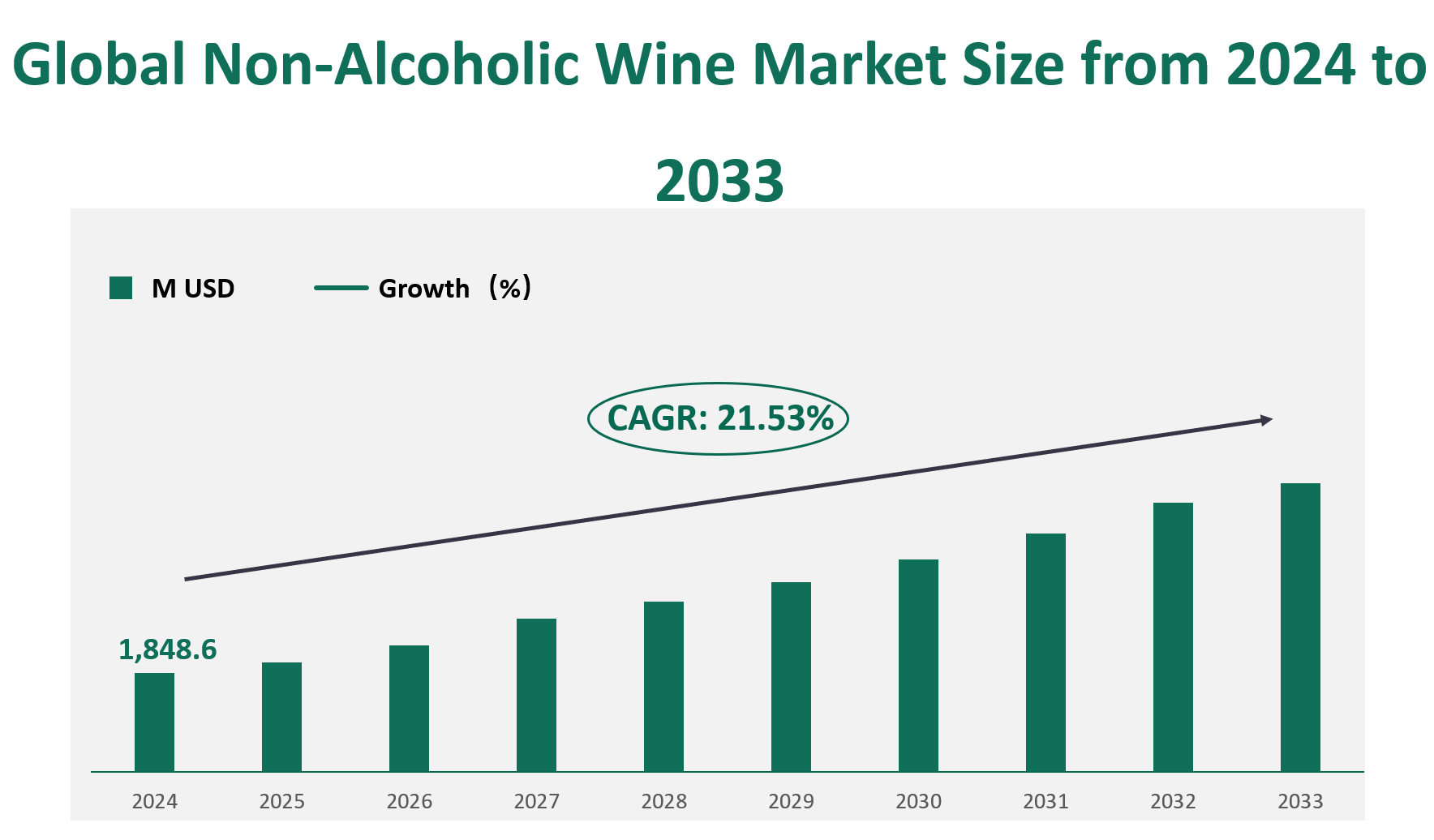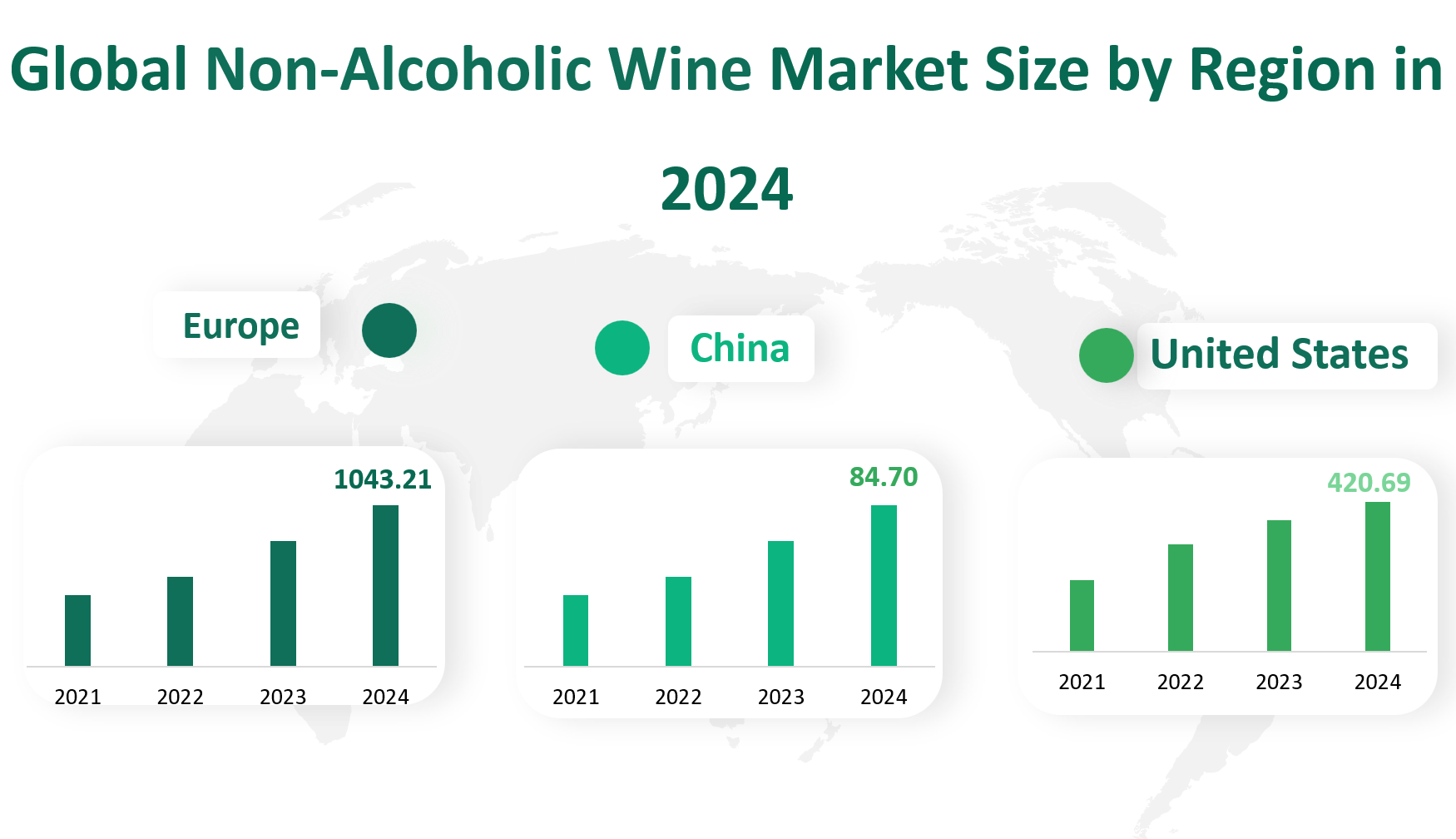1. Global Non-Alcoholic Wine Market Insight Analysis
In 2024, the global non-alcoholic wine market revenue is projected to reach 1,848.6 million USD, with a Compound Annual Growth Rate (CAGR) of 21.53% from 2024 to 2033.
Non-alcoholic wine is defined as a beverage derived from traditional wine-making processes, where the alcohol content is significantly reduced or removed. This is typically achieved through methods such as vacuum distillation or reverse osmosis, which remove the alcohol while preserving the flavor profile of the original wine. Despite the name, non-alcoholic wines may contain trace amounts of alcohol, usually less than 0.5% ABV (alcohol by volume). The market segment includes both “alcohol-free” wines, which have negligible alcohol content, and “low-alcohol” wines, which contain slightly higher but still minimal levels of alcohol. This distinction allows consumers to choose products based on their preferences and dietary or health requirements.
Figure Global Non-Alcoholic Wine Market Size (M USD) and CAGR (2024-2033)

2. Driving and Limiting Factors of Non-Alcoholic Wine Market Growth
The growth of the non-alcoholic wine market is driven by several key factors. Firstly, health consciousness among consumers is a major driver. Non-alcoholic wines are perceived as healthier alternatives to traditional alcoholic beverages, with lower calorie counts and potential health benefits such as reduced blood pressure and lower risk of heart disease. This aligns with the global trend towards healthier lifestyles and increased awareness of the impact of alcohol consumption on health.
Secondly, expanding consumer demographics play a significant role. Non-alcoholic wines cater to a broader audience, including pregnant women, designated drivers, and individuals who prefer to avoid alcohol for personal or religious reasons. The market also appeals to younger consumers who are increasingly interested in unique and flavorful beverage options without the intoxicating effects of alcohol.
However, the market also faces several limiting factors. One of the primary challenges is consumer perception. Many consumers still associate wine with its alcoholic content, and non-alcoholic alternatives may be perceived as inferior in taste or quality. This perception is reinforced by the fact that replicating the complex flavors and textures of traditional wine is technically challenging, leading to potential taste differences that can deter some consumers.
Another limiting factor is the higher production costs associated with non-alcoholic wine. The processes required to remove alcohol, such as vacuum distillation and reverse osmosis, are expensive and require specialized equipment. Additionally, marketing efforts to promote non-alcoholic wines as premium products further increase costs, making these beverages more expensive than traditional wines. This can limit market penetration, particularly in price-sensitive markets.
3. Technology Innovation and Corporate Mergers and Acquisitions in Non-Alcoholic Wine Market
Technological advancements are playing a crucial role in the development of the non-alcoholic wine market. Innovations in production techniques are addressing the key challenge of preserving the flavor and aroma of wine while removing alcohol. For example, German researchers have developed new processes that enhance the aroma and restore flavors lost during the dealcoholization process. These advancements are helping to bridge the gap between traditional and non-alcoholic wines, making the latter more appealing to a wider consumer base.
Corporate mergers and acquisitions are also shaping the market landscape. Companies are increasingly looking to expand their portfolios through strategic partnerships and acquisitions. For instance, Riboli Family Wines acquired Jada Vineyard & Winery in Paso Robles, California, to enhance its production capabilities and tap into the growing demand for premium non-alcoholic wines. Such moves not only strengthen market positions but also drive innovation and investment in the sector.
4. Global Non-Alcoholic Wine Market Size by Type
Non-alcoholic wine is a beverage that undergoes a similar production process to traditional wine but has the alcohol content removed through various methods such as vacuum distillation or reverse osmosis. This category is primarily divided into two types: Alcohol-Free and Low-Alcoholic wines.
Alcohol-free wine is defined as a beverage with an alcohol by volume (ABV) of 0.0%. Despite the name, these wines may contain trace amounts of alcohol, typically less than 0.5% ABV. This type of wine is produced by removing alcohol from traditional wine while retaining the flavor profile through the addition of fruit juices or flavor additives. Alcohol-free wines are popular among consumers who prefer a non-alcoholic beverage but still desire the taste and experience of wine. In 2024, the market revenue for alcohol-free wine is projected to be approximately $602.09 million. This segment holds a market share of about 32.57%.
Low-alcoholic wine, on the other hand, contains a small amount of alcohol, typically less than 0.5% ABV. This type of wine is produced through vacuum distillation, which removes most of the alcohol while preserving the wine’s flavor and aroma. Low-alcoholic wines are popular among consumers who enjoy the taste of wine but want to limit their alcohol intake. In 2024, the market revenue for low-alcoholic wine is forecasted to be around $1,246.51 million, accounting for 67.43% of the total market share.
Table Global Non-Alcoholic Wine Market Size by Type in 2024
5. Global Non-Alcoholic Wine Market Size by Application
The non-alcoholic wine market is applied across various channels, each serving different consumer needs and preferences. These applications include liquor stores, convenience stores, supermarkets, online stores, restaurants, and other venues.
Liquor stores are retail shops that specialize in selling prepackaged alcoholic beverages, including non-alcoholic wines. These stores often offer a wide variety of wines and provide a convenient shopping experience for consumers. In 2024, the market revenue for non-alcoholic wine sold through liquor stores is projected to be $778.41 million, accounting for 42.11% of the total market share.
Convenience stores offer a range of everyday items, including non-alcoholic wines. These stores are known for their accessibility and quick service, making them a popular choice for consumers seeking a convenient shopping experience. In 2024, the market revenue for non-alcoholic wine sold through convenience stores is estimated to be $220.46 million, representing 11.93% of the total market share.
Supermarkets are large retail stores that offer a wide variety of products, including non-alcoholic wines. These stores cater to consumers who prefer to purchase their beverages alongside other groceries. In 2024, the market revenue for non-alcoholic wine sold through supermarkets is forecasted to be $207.79 million, accounting for 11.24% of the total market share.
Online stores have become increasingly popular in recent years, offering consumers the convenience of shopping from home. These platforms provide a wide selection of non-alcoholic wines and often offer promotions and discounts. In 2024, the market revenue for non-alcoholic wine sold through online stores is projected to be $252.49 million, representing 13.66% of the total market share.
Restaurants offer non-alcoholic wines as an alternative to traditional alcoholic beverages, catering to a diverse range of customers, including children, pregnant women, and those who prefer not to drink alcohol. In 2024, the market revenue for non-alcoholic wine sold through restaurants is estimated to be $178.40 million, accounting for 9.65% of the total market share.
Table Global Non-Alcoholic Wine Market Size by Application in 2024
Application | Market Size (M USD) 2024 | Market Share |
Liquor Stores | 778.41 | 42.11% |
Convenience Stores | 220.46 | 11.93% |
Supermarkets | 207.79 | 11.24% |
Online Stores | 252.49 | 13.66% |
Restaurants | 178.40 | 9.65% |
Others | 211.04 | 11.42% |
6. Global Non-Alcoholic Wine Market by Top Regions
Europe emerged as the largest market by revenue, accounting for 1043.21 million USD in 2024. This dominant position can be attributed to several factors, including a long-standing wine culture, a high level of consumer awareness about health and wellness, and the presence of numerous established wineries that have successfully transitioned to producing non-alcoholic alternatives.
The United States is another significant market, generating 420.69 million USD in revenue in 2024. The growth in this region is fueled by increasing health consciousness among consumers, a growing trend towards mindful drinking, and the expanding availability of non-alcoholic wine options in both online and offline retail channels.
China is a rapidly growing region. In 2024, the region’s revenue reached 84.70 million USD. The growth is driven by increasing consumer awareness about the health benefits of non-alcoholic beverages and the rising popularity of Western-style dining and drinking cultures.
Latin America also showed strong growth, with a revenue of 120.37 million USD in 2024. The region’s growth is attributed to increasing urbanization, rising disposable incomes, and a growing middle class that is more willing to explore new and healthier beverage options.
Middle East and Africa contributed 35.13 million USD to the global non-alcoholic wine market in 2024.
Figure Global Non-Alcoholic Wine Market Size by Region in 2024

7. Global Non-Alcoholic Wine Market Analysis by Major Players
7.1 Castel Frères
Introduction and Business Overview:
Castel Frères is a leading French beverage company founded in 1949. The company is renowned for its diverse portfolio of wines, including traditional and non-alcoholic options. Castel Frères focuses on producing high-quality wines using sustainable practices and innovative production techniques.
Products Offered:
Castel Frères offers a range of non-alcoholic wines under the brand name Grain d’Envie. These products include red and rosé varieties, known for their delicate flavors and low-calorie content. The company’s non-alcoholic wines are produced using advanced dealcoholization processes that preserve the aroma and taste of traditional wines.
Sales Revenue in 2023:
In 2023, Castel Frères generated a revenue of $35.42 million USD from its non-alcoholic wine segment.
7.2 Trinchero Family Estates
Introduction and Business Overview:
Trinchero Family Estates is a prominent American winery founded in 1948. The company is known for its commitment to sustainability and innovation in winemaking. Trinchero Family Estates produces a wide range of wines, including non-alcoholic options, and has a strong presence in both domestic and international markets.
Products Offered:
Trinchero Family Estates offers several non-alcoholic wine varieties, including White Zinfandel and other fruit-flavored options. These products are designed to appeal to health-conscious consumers and those looking for low-calorie alternatives to traditional wines.
Sales Revenue in 2023:
The company’s non-alcoholic wine segment generated a revenue of $50.75 million USD in 2023, reflecting its strong market position and consumer acceptance.
7.3 Stella Rosa Wines
Introduction and Business Overview:
Stella Rosa Wines is a well-known American winery founded in 1917. The company is famous for its innovative and flavorful wines, including a range of non-alcoholic options. Stella Rosa Wines focuses on producing high-quality wines that cater to diverse consumer preferences.
Products Offered:
Stella Rosa Wines offers a variety of non-alcoholic wines, including black, peach, red, and rosé flavors. These products are known for their fresh fruit flavors and low-calorie content, making them popular among health-conscious consumers.
Sales Revenue in 2023:
In 2023, Stella Rosa Wines achieved a revenue of $56.16 million USD from its non-alcoholic wine segment, highlighting its strong market presence and consumer appeal.

